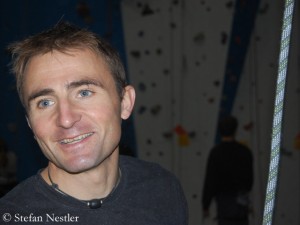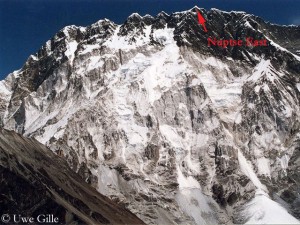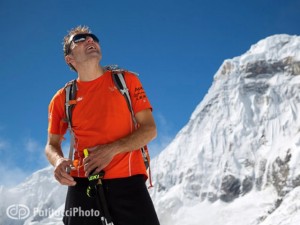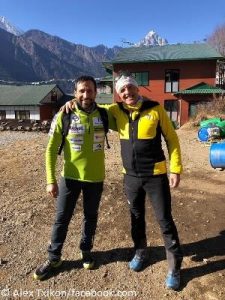Steck: “The only way I can help the people of Nepal”
There are only 20 days left until Ueli Steck will return to Nepal. To the country where the 38-year-old Swiss top climber in the same year celebrated his probably most spectacular success as an extreme climber as well as the greatest fear of death that had nothing to do with mountain dangers. In spring 2013, a group of angry Sherpas attacked Ueli and his teammates Simone Moro and Jonathan Griffith in Everest high camp and threatened them with death. In fall 2013, Steck reached the 8091-meter-high summit of Annapurna, the eight-thousander with the highest fatality rate: solo, via the extremely dangerous South Face, on a partly new route, as always without bottled oxygen. It took Ueli only 28 hours to climb up and down.
This summer, he proved once again that he is able to climb mountains lickety-split, when he – as reported in my blog – scaled all 82 four-thousanders of the Alps within 62 days and overcame the distance between the mountains without engine power: by hiking, cycling or paragliding. I talked to Ueli about his tour de force through the Alps – and also about his upcoming exciting project in Nepal: on Nuptse, within sight of Mount Everest.
Ueli, before starting your project “82 Summits” you told me that you wanted to turn back the screw of risk a bit and to have just fun. Did you experience this fun in the 62 days you needed to climb all four-thousanders of the Alps?
It was actually one of the best projects I’ve ever done. Every day it was fun. In addition I was extremely lucky with the weather.
How great were the physical strain and thus the sporting value for you?
At the end I had made 117,000 meters of altitude which means a certain amount of physical stress. The sporting value is still difficult to assess at the moment. But it has a rather great value for me, because I always had everything under control. I always was able to recover well and never had any problems with my body.
Your original partner for the project, the German climber Michi Wohlleben, had to give up early, because he got injured while attempting to land after a paragliding flight. Afterwards you climbed with many different partners, among others with your wife Nicole. Did you enjoy that?
Actually, this has led the project in a completely different direction. It was really awesome to climb with such different people. For instance, when I was climbing with my wife, it had priority to enjoy a beautiful mountain trip. When I climbed with Andy Steindl I could speed up. Thus I had every day a different approach.
Now you’re really well trained, you have often enough been higher than 4,000 meters, so that you are well acclimatized – ideal conditions to tackle the very high mountains.
Yes, I do believe that I now have a solid basis and a good physical condition to go to Nepal.
Are you still planning to climb along with the American Colin Haley the so called “Babanov-Route” on the 7,804-meter-high Nuptse East in Alpine style this fall?
Exactly. We fly to Nepal on 22 September. And then we’ll see what happens.
What does this project make so appealing for you?
It is a technically challenging route that has never been repeated. When Valeri Babanov and Yuri Kosholenko first climbed this route (via the Southeast Pillar in 2003), they used fixed ropes. I have a feeling that it is now really possible to tackle this difficult route in Alpine style. And that excites me.
You will set off with a climbing partner. How high is the probability that it turns again to be a solo project at the end?
(He laughs) No, that’s finished for me. During my “82 Summits” project, it was once again so that Michi had to leave. But no, I will no longer do such actions as on Annapurna.
It will be your return to a region where you had anything but good experiences in spring 2013. You were attacked in Everest high camp by angry Sherpas. Do you still have a queasy feeling?
Of course, I will never forget this. It’s in my mind. But I had several years now to think about it, to talk to people about it and to get to grips with the whole thing. There were just a few extremists. But there are a few odd people anywhere in the world. For me it’s finished, and I look forward.
In the meantime, a lot has happened in Nepal: two deadly avalanches on Everest; the devastating earthquake; as a consequence few trekking tourists and expeditions this fall. Do you also want to give a signal with your project: Guys, I’m not afraid to go there?
Of course, I am still a bit scared: Will there be another strong earthquake? It’s not funny when you’re in the mountains then. On the other hand it is the only way I can really help the people in Nepal: by traveling there, giving them jobs and thus creating opportunities for them that life goes on.
Do you feel a particular responsibility as a professional climber who was often in Nepal to give the country something back in this difficult situation?
For me it is a matter of course that I try to help as much as I can. I do not think that it is enough to send aid only. At the end of the day, that doesn’t bring a country like Nepal anything. In the beginning it was important, of course, and it did happen. But now people must have jobs, so that they have income. That has always been important to me, and it was the reason that I’ve come to Nepal again and again: to ensure that the life of the people I know and who I have supported goes on.
P.S. May I remind you of our donation campaign “School up!” to rebuild the school in Thulosirubari in the Nepalese district Sindhupalchowk that was destroyed by the 25 April earthquake. You find all details on the right side of the blog and reports at the top bar.











